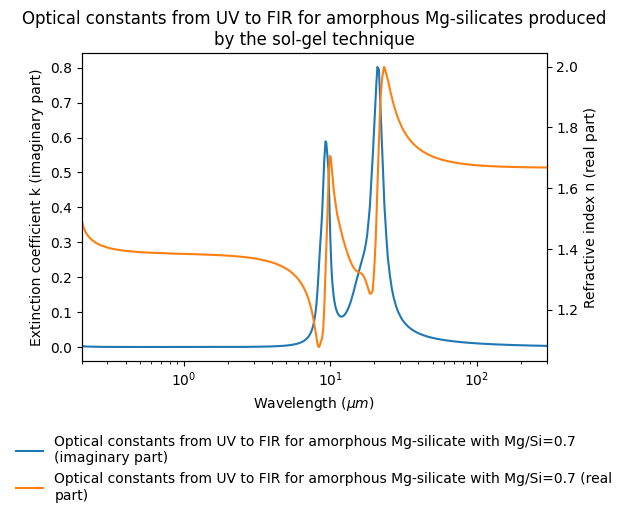- Title
- Optical constants from UV to FIR for amorphous Mg-silicates produced by the sol-gel technique
- DOI
- 10.26302/SSHADE/EXPERIMENT_HM_20170913_020
- Data reference
- Jäger, Cornelia; Dorschner, Johann; Mutschke, Harald; Posch, Thomas; Henning, Thomas (2001): Optical constants from UV to FIR for amorphous Mg-silicates produced by the sol-gel technique. SSHADE/DOCCD (OSUG Data Center). Dataset/Spectral Data. https://doi.org/10.26302/SSHADE/EXPERIMENT_HM_20170913_020
- Publications
- Database(s)
- Experimentalists
- Type(s)
- laboratory measurement
- Number of spectra
- 5
- Variable type(s)
-
- sample composition
- Instrument
- Lambda 19 – reflection UV
- Standard medium
- air
- Observation mode
- spectrum
- Spectral range type(s)
- UV
- Valid spectral range(s)
-
Min - Max (${\mu}m$) Sampling (${\mu}m$) Resolution (${\mu}m$) Position accuracy (${\mu}m$) Absorption edge #1 0.2 - 0.319 0.0005
Definition: incidence and emergence angles are positive with origin at nadir, and vary in same direction. Azimuth origin (increasing clockwise) is for i = e (opposition geometry).
- Observation geometry
- specular
- Observation mode
- fixed angles
- Incidence angle
- 12.0°
- Emergence angle
- 12.0°
- Resolution illumination
- 6.0°
- Resolution observation
- 6.0°
Illumination
- Type of polarization
- no
Observation
- Type of polarization
- no
- Observation mode
- single spot
- Spatial resolution
- 5.0 $mm$
- Instrument
- Lambda 19 – reflection vis
- Standard medium
- air
- Observation mode
- spectrum
- Spectral range type(s)
- Vis
- Valid spectral range(s)
-
Min - Max (${\mu}m$) Sampling (${\mu}m$) Resolution (${\mu}m$) Position accuracy (${\mu}m$) Absorption edge #1 0.319 - 0.86 0.0005
Definition: incidence and emergence angles are positive with origin at nadir, and vary in same direction. Azimuth origin (increasing clockwise) is for i = e (opposition geometry).
- Observation geometry
- specular
- Observation mode
- fixed angles
- Incidence angle
- 12.0°
- Emergence angle
- 12.0°
- Resolution illumination
- 6.0°
- Resolution observation
- 6.0°
Illumination
- Type of polarization
- no
Observation
- Type of polarization
- no
- Observation mode
- single spot
- Spatial resolution
- 5.0 $mm$
- Instrument
- Lambda 19 – reflection NIR
- Standard medium
- air
- Observation mode
- spectrum
- Spectral range type(s)
- NIR
- Valid spectral range(s)
-
Min - Max (${\mu}m$) Sampling (${\mu}m$) Resolution (${\mu}m$) Position accuracy (${\mu}m$) Absorption edge #1 0.86 - 2.5
Definition: incidence and emergence angles are positive with origin at nadir, and vary in same direction. Azimuth origin (increasing clockwise) is for i = e (opposition geometry).
- Observation geometry
- specular
- Observation mode
- fixed angles
- Incidence angle
- 12.0°
- Emergence angle
- 12.0°
- Resolution illumination
- 6.0°
- Resolution observation
- 6.0°
Illumination
- Type of polarization
- no
Observation
- Type of polarization
- no
- Observation mode
- single spot
- Spatial resolution
- 5.0 $mm$
- Instrument
- BRUKER 113v – reflection Mid-IR
- Standard medium
- vacuum
- Observation mode
- spectrum
- Spectral range type(s)
- MIR
- Valid spectral range(s)
-
Min - Max (${\mu}m$) Sampling (${\mu}m$) Resolution (${\mu}m$) Position accuracy (${\mu}m$) Absorption edge #1 2.0 - 25.0
Definition: incidence and emergence angles are positive with origin at nadir, and vary in same direction. Azimuth origin (increasing clockwise) is for i = e (opposition geometry).
- Observation geometry
- specular
- Observation mode
- fixed angles
- Incidence angle
- 12.0°
- Emergence angle
- 12.0°
- Resolution illumination
- 6.0°
- Resolution observation
- 6.0°
Illumination
- Type of polarization
- no
Observation
- Type of polarization
- no
- Observation mode
- single spot
- Spatial resolution
- 5.0 $mm$
- Instrument
- BRUKER 113v – reflection Far-IR
- Standard medium
- vacuum
- Observation mode
- spectrum
- Spectral range type(s)
- FIR
- Valid spectral range(s)
-
Min - Max (${\mu}m$) Sampling (${\mu}m$) Resolution (${\mu}m$) Position accuracy (${\mu}m$) Absorption edge #1 15.0 - 300.0
Definition: incidence and emergence angles are positive with origin at nadir, and vary in same direction. Azimuth origin (increasing clockwise) is for i = e (opposition geometry).
- Observation geometry
- specular
- Observation mode
- fixed angles
- Incidence angle
- 12.0°
- Emergence angle
- 12.0°
- Resolution illumination
- 6.0°
- Resolution observation
- 6.0°
Illumination
- Type of polarization
- no
Observation
- Type of polarization
- no
- Observation mode
- single spot
- Spatial resolution
- 5.0 $mm$
- Date begin
- 2001-01-01
Versions
- Release date
- 2019-08-26 08:12:26+0000 UTC
- Version (Date)
- #1 (2019-08-26 08:12:26+0000 UTC, Updated: 2019-08-19 09:36:58+0000 UTC)
